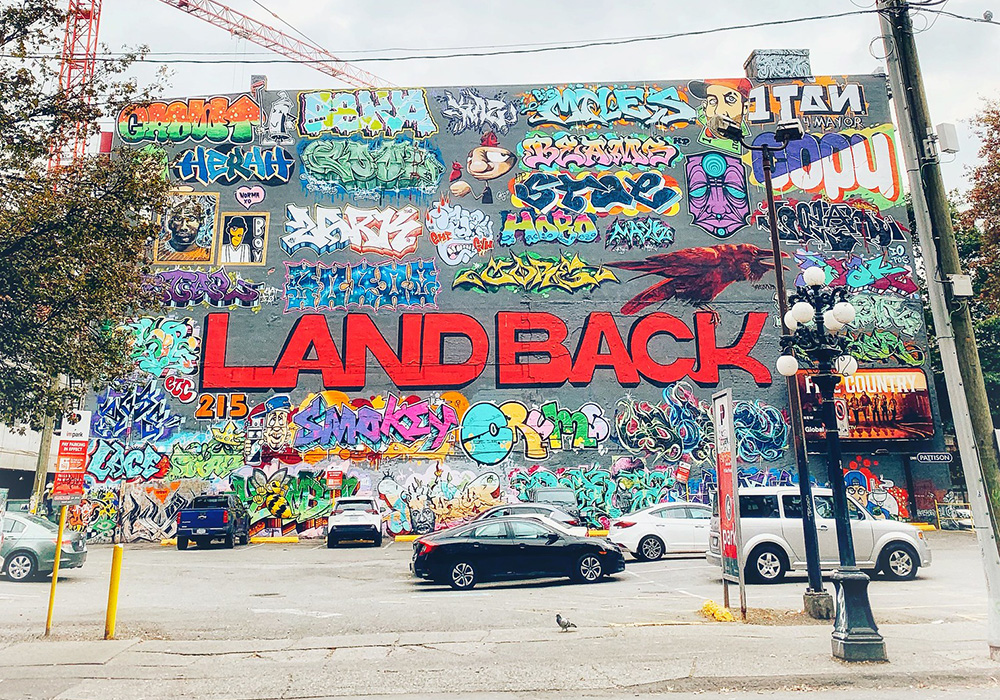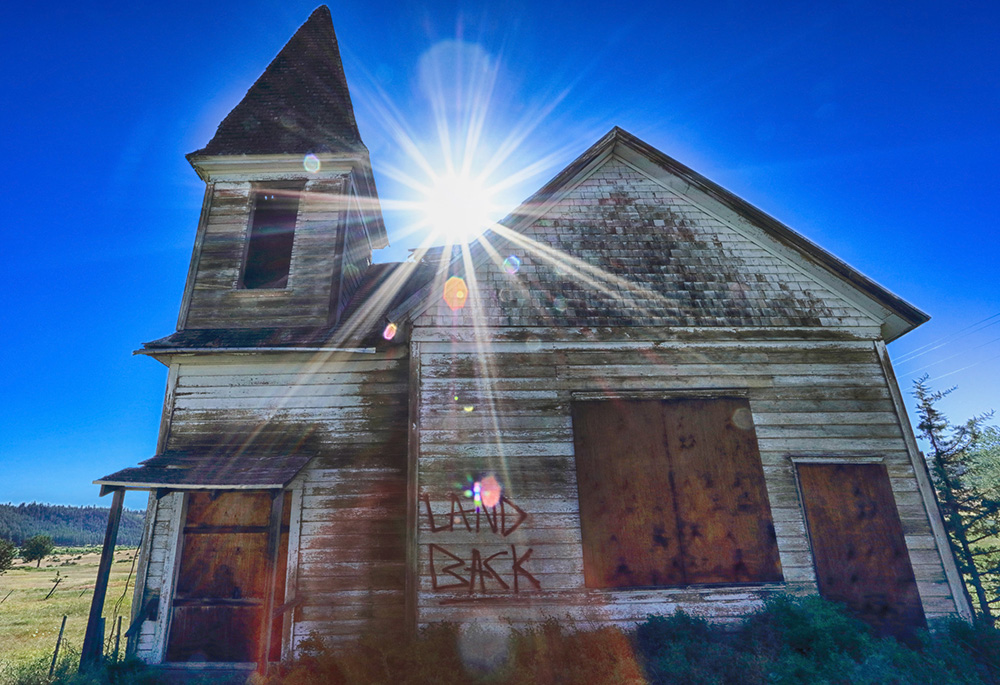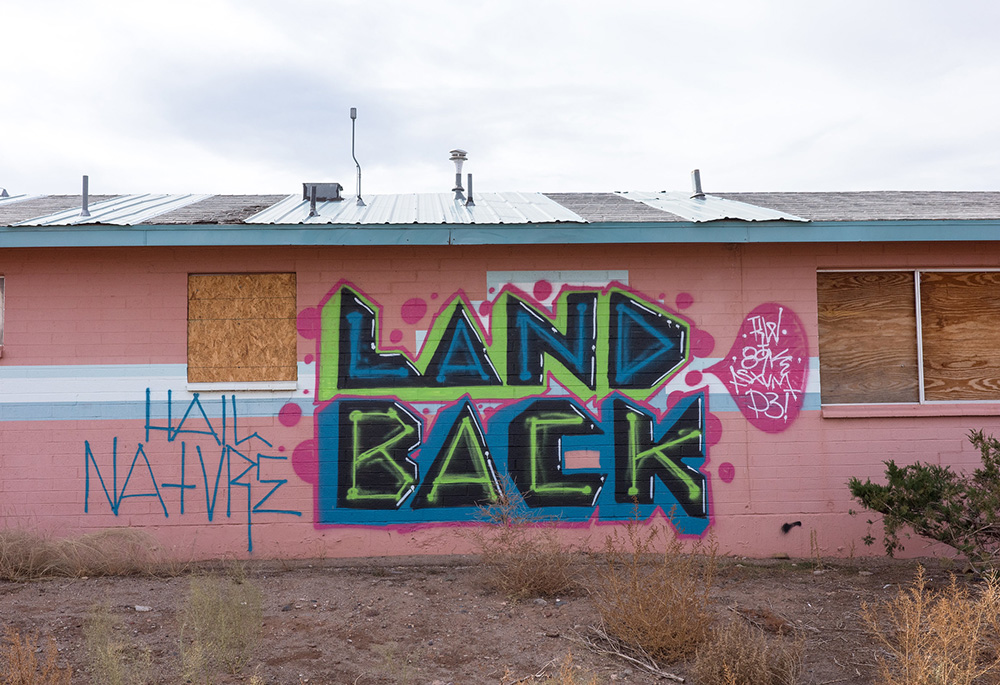
"Abbott Street," a photo of graffiti that says "Landback," taken Oct. 22, 2022, in Vancouver. (Flickr/Edna Winti, CC BY 2.0)
As a growing land return movement, Landback is a diverse and global process. From the return of national parks to the Eastern Kuku Yalanji in Australia, to the reclaiming of Tuluwat Island, a Wiyot sacred site near Eureka, California, Landback is gaining in global strength. Although each land return initiative is distinct and specific to its place and relationality, as a movement gaining ground across the globe, Landback is a proper noun.
When the Vatican repudiated the "Doctrine of Discovery" in March 2023, it sparked renewed calls for the Catholic Church to return Indigenous lands. As the progenitor of colonial land theft, an allegedly pro-life institution and a global power that owns a large amount of land, the Catholic Church is in need of a systematic, institutional strategy for returning its lands to Indigenous nations.
What is 'Land' in the Landback context?
Environmental scientist Max Liboiron (Red River Métis/Michif) defines Land as a "unique entity that is the combined living spirit of plants, animals, air, water, humans, histories, and events recognized by many Indigenous communities." Liboiron capitalizes Land to signify it as more than mere landscape, or inert space that can be understood primarily as property.
Waroani leader Nemonte Nenquimo says the Amazon forest (the trees, the waters and other more-than-human relatives) is teacher, home, life-giver, nourisher, spiritual connection — as well as material place.
Japanese ethnographer Chie Sakakibura explains that to be Iñupiat "is to be formed relationally with other nonhuman persons." Iñupiat elder Suuyuk Lane Sr. asserts, "The whale makes us human."
For Indigenous people, Land is relational. It is not merely property or resource, but a network of specific, place-based relationality that operates as a life web reaching beyond temporal notions of time and dominant geographic notions of space.
Advertisement
Echoes of this relational understanding of Land arise in other communities as well.
Ecowomanist scholar Melanie Harris names the earth's cry in our era of climate change as prophecy, connecting the dominating logic of anti-Black racism and anthropocentric environmental norms. She states, "The trees stand as living witness."
Trees witnessed the lynchings of black bodies in the U.S. South that began in the 19th century. And they witnessed the police bullets that killed environmental activist Manuel Paez Terán in 2023, who died protesting the creation of "Cop City" in Atlanta, Georgia, that would have torn down 85 acres of the South River Forest. Their mother, Belkis Terán, told reporters of her child, "The forest connected them with God."
The forests in Quebec that burned in 2023 are witnesses of colonialism, victims of climate change, and survivors.
Land witnesses and remembers and connects us to God. And Land is also much more. Liboiron stresses that Land is not a noun. Land is a verb. And, in the U.S. context, all Land is Indigenous Land.

"Land back" is painted on a crumbling, abandoned church located on Oregon's Warm Springs Indian Reservation, June 25, 2022. (Flickr/Ian Sane, CC BY 2.0)
What is Indigenous land return, or Landback?
Landback is a global movement of Indigenous sovereignty that initiates the return of territory (place) previously removed from Indigenous nations due to initiatives of colonization, or in the U.S., settler colonialism. Settler colonial initiatives include ongoing land dispossession, the breaking of treaties and untenable resource extraction. Thus, the property the Catholic Church owns in the Americas is stolen. It is not Catholic, but Indigenous.
Landback also involves the restoration of Indigenous peoples beyond the physical transfer of land. It involves the restoration of relationships that are continuously severed or damaged in the ongoing project of non-Indigenous settlement, also known as the United States.
Few Catholic communities have participated in the return of Indigenous lands, but there are some examples of what this looks like.
In South Dakota in 2017, about 525 non-continuous acres of the Rosebud Sioux Reservation were returned to the Rosebud Sioux Tribe. This land, scattered throughout what is today a 900,000 acre reservation, was transferred to the Jesuits of the Midwest Province by the federal government in the 1880s, likely as a result of the Dawes Act of 1887. The Dawes Act, passed during the Allotment and Assimilation era of U.S. federal Indian law, included a provision for Christian religious communities to retain 160 acres of reservation lands for evangelization purposes, while Indigenous religious practices were made illegal. The Jesuits used Rosebud Sioux lands to build Catholic churches and cemeteries within the reservation. This included the St. Francis Mission, one of the federal Indian boarding schools run by the Jesuits.
In 2023, the Ahtna Native Alaskan Tazlina village, a federally recognized tribal member of the Alaska Native corporation Ahtna Inc., successfully raised the funds to purchase about 412 acres of land that houses traditional fish wheel sites along the confluence of the Tsedi Na (Copper) River and the Tezdlen Na (Tazlina) River. This site, first seized by the Russians, then bought by the U.S. federal government, was purchased by the Archdiocese of Anchorage in the 1950s for $1.25 per acre, and became the Copper River federal Indian boarding school. The school shut down in 1971, and burned to the ground five years later, contaminating the site.
Beginning with conversations at tribal council meetings in the 1990s, the Tazlina Village Council began discussing cleanup. In 2011, then-Chief Johnny Goodlataw led the village in a "vision to action" workshop to begin planning the return of these lands to the village. Through the following seven years of advocacy and processes with various partners, the village persisted in their efforts to return the land.
In 2018, Tazlina Village, in a "leap of faith," entered into a contract with the Anchorage Archdiocese to attempt to purchase the site for $1.86 million. ICT reported in June 2023 that "the village raised the money and expects to close on the land this spring."
The relationality of Ahtna Land is made plain in the tribal council's statement: "What were once indigenous Ahtna hunting and fishing lands will now be returned to our people. This gift of life means we can walk and fish on the land on where our ancestors walked, for which we are profoundly thankful."
These two places, roughly 3,000 miles apart, offer storied examples of where the Catholic Church and the global movement for Indigenous land return meet.

"Land back" wall art is pictured Nov. 23, 2023, near Monument Valley, Arizona. (Flickr/Kevin Dooley, CC BY 2.0)
Catholic return of Indigenous Lands
Indigenous land reclamation is happening in a variety of ways. In Tazlina, this occurred via private sale. Other examples include title transfers. Still lacking in the Catholic Church, however, is a truly systemic approach to this issue. How might the Catholic Church begin to systematically envision the return of Catholic-held Indigenous lands?
Deborah Parker (Tulalip) the CEO of the National Native American Boarding School Healing Coalition, offered three practical suggestions: provide access to Catholic Indian boarding school documents; return boarding school lands to the Tribal Nations they were originally stolen from; and politically support the Truth and Healing Bill.
Both Tazlina Village and Rosebud Sioux Reservation were sites of former federal Indian boarding schools. How might the Catholic Church hold itself accountable to its role in Indigenous dispossession that includes but goes beyond former boarding schools? How might it leverage its pro-life philosophies to systemically implement the return of Indigenous Lands?
Considering the isolated, uneven responses we've seen from the church, I would add a fourth consideration to Parker's three action items: The United States Conference of Catholic Bishops could reconfigure the Black and Indian Mission Office, or BIMO.
Composed of three historical agencies — the Bureau of Catholic Indian Missions, the Commission For the Catholic Missions, and the Catholic Negro-American Mission Board — the Black and Indian Mission Office operates to fund Black and Indigenous Catholic communities. To do so, it seeks donations primarily through a Lenten annual appeal. In 2005, the appeal exceeded $9 million for the first time. These monies are directed toward such initiatives as the National Black Catholic Conference and the Tekakwitha Conference.
Yet, despite the funding of the contemporary lives of Black and Indigenous Catholics, this ministry narrates these communities as outside the fold of Catholicism and in need of evangelization. (Per the website, the "People of God" fund the "building" of Christ's body in these non-white communities.) Such narratives maintain the racism of the institutional church, as Fr. Bryan Massingale and Fr. Joseph Brown have elaborated. Where, for example, is the Lenten collection for the evangelization of white people?
In sharp contrast to survivor testimony of Catholic-run federal Indian boarding schools, BIMO's apologist history as told on their website bemoans their institutional lifespan as a truncated one: "This remarkable success [of Catholic boarding schools] had unfortunate results. Other denominations, jealous of Catholic successes in this area, began to lobby for an end to the funding for all Indian schools." This history also illustrates a specifically Catholic fear of losing access to Indigenous Land: "In 1859, fearful that homesteaders and others might challenge the ownership of mission lands, Bishop [Augustin] Blanchet sent Father [John Baptist] Brouillet East ... to protect mission property by securing clear titles."
The church required land titles in order to successfully "kill the Indian" in these children — allegedly saving their souls through a system whose sole intent was dispossessing tribal nations of their Land.
What might be gained by reworking the Black and Indian Mission Office to include funding for Indigenous communities seeking land return? How might the church repent from its ongoing attempts to "evangelize" non-white communities, and instead seek, in the case of Indigenous people, to return the Land it has stolen?
Taking accountability for the church's role in Indigenous genocide and land dispossession requires a greater collective imagination. It requires a reworking of current funding, and perhaps the creation of non-evangelical "ministries" foregrounding accountability at the level of the Vatican and the various conferences of bishops in the Americas. It requires a commitment to institutional political activity that supports Indigenous life and Land return.
What else can we envision as a church to bring true accountability for the institution's sin? How can the body of Christ work for the flourishing of Indigenous Catholic and non-Catholic life?
Individually, the work has begun. As an institution, it's time for the Catholic Church to give the Land back.
Author's note: I am deeply grateful to my students at Haverford College from the 2023 spring semester. Our conversations, and their amazing research on various Landback movements, provided the backbone of this writing project. Carmen Siftar, thank you especially for your gift of content editing for this piece. Quyaana, friends!








